

Incompétence digitale Livre blanc Vodeclic. Comprendre le Web. Sal Khan: Reimagining Education. How Teachers Can Use Video Games In The Humanities Classroom. Part 12 of MindShift’s Guide to Games and Learning.
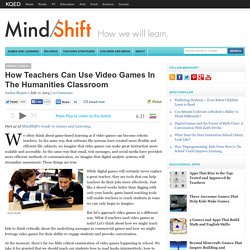
We often think about game-based learning as if video games can become robotic teachers. In the same way that software file systems have created more flexible and efficient file cabinets, we imagine that video games can make great instruction more scalable and accessible. In the same way that email, text messages, and social media have provided more efficient methods of communication, we imagine that digital analytic systems will streamline assessment. These things are true. Erin Scott While digital games will certainly never replace a great teacher, they are tools that can help teachers do their jobs more effectively. But let’s approach video games in a different way.
The 4 Levels Of Learning Analytics. Jane McGonigal: Massively multi-player… thumb-wrestling? Jane McGonigal: Gaming can make a better world. Stuart Brown: Play is more than just fun. Et si les neurosciences pouvaient aider le changement ? #neuroscience par @ceciledemailly. 01net. le 20/08/12 à 10h15 © © 2009 SanFranAnnie, Flickr Cet été, je déjeune en terrasse avec une amie, l’une des gourous 2.0 d’une multinationale française, et nous parlons conduite du changement (oui, oui, même en terrasse l’été).
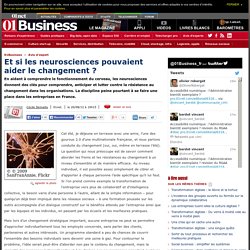
La question qui nous préoccupe est de savoir comment aborder les freins et les résistances au changement à un niveau d’ensemble et de manière efficace. Au niveau individuel, il est possible assez simplement de cibler et d’apporter à chaque personne l’aide spécifique qu’il lui faut. Principle I. Provide Multiple Means of Representation. Click to Get the Guidelines!
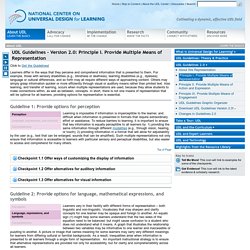
Learners differ in the ways that they perceive and comprehend information that is presented to them. For example, those with sensory disabilities (e.g., blindness or deafness); learning disabilities (e.g., dyslexia); language or cultural differences, and so forth may all require different ways of approaching content. Others may simply grasp information quicker or more efficiently through visual or auditory means rather than printed text. Also learning, and transfer of learning, occurs when multiple representations are used, because they allow students to make connections within, as well as between, concepts. In short, there is not one means of representation that will be optimal for all learners; providing options for representation is essential.
Guideline 1: Provide options for perception Checkpoint 1.1 Offer ways of customizing the display of information In print materials, the display of information is fixed and permanent. Tell Me More! Suggested citation. Principle III. Provide Multiple Means of Engagement. Click to Get the Guidelines!

Affect represents a crucial element to learning, and learners differ markedly in the ways in which they can be engaged or motivated to learn. There are a variety of sources that can influence individual variation in affect including neurology, culture, personal relevance, subjectivity, and background knowledge, along with a variety of other factors. Some learners are highly engaged by spontaneity and novelty while other are disengaged, even frightened, by those aspects, preferring strict routine. Some learners might like to work alone, while others prefer to work with their peers. In reality, there is not one means of engagement that will be optimal for all learners in all contexts; providing multiple options for engagement is essential.
Guideline 7: Provide options for recruiting interest. Principle II. Provide Multiple Means of Action and Expression. Click to Get the Guidelines!
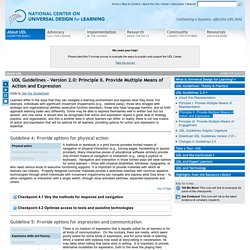
Learners differ in the ways that they can navigate a learning environment and express what they know. For example, individuals with significant movement impairments (e.g., cerebral palsy), those who struggle with strategic and organizational abilities (executive function disorders), those who have language barriers, and so forth approach learning tasks very differently. Some may be able to express themselves well in written text but not speech, and vice versa. It should also be recognized that action and expression require a great deal of strategy, practice, and organization, and this is another area in which learners can differ.
In reality, there is not one means of action and expression that will be optimal for all learners; providing options for action and expression is essential. TeachThought - Learn better. The World’s Largest Training and Development Association. Open Education 2030. Les nouveaux défis du Responsable formation & développement. Dans un contexte de réforme de la formation professionnelle vers, peut-être, « un choc de simplification » et la fin annoncée du 0,9%, le métier de « Responsable Formation » évolue, au plus près des enjeux de l’organisation.Ce positionnement stratégique se traduit financièrement par une rémunération du « Responsable formation & développement » qui arrive en deuxième position après celle du DRH, pour un montant médian de 62 000 € (Source Towers Watson, Tous les salaires de la fonction RH, 2013).
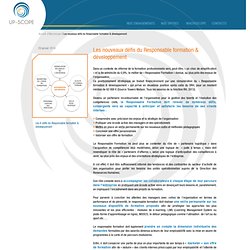
Devenu un partenaire incontournable de l’organisation pour la gestion des talents et l’évolution des compétences clefs, le Responsable Formation doit relever de nombreux défis, convergents vers sa capacité à anticiper et satisfaire les besoins de ses clients internes : A cet effet, il doit être suffisamment informé des tendances et des contraintes du secteur d’activité de son organisation pour porter les besoins des unités opérationnelles auprès de la Direction des Ressources Humaines. • Etc… The FLTmag.